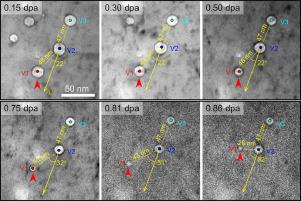当前位置:
X-MOL 学术
›
Acta Mater.
›
论文详情
Our official English website, www.x-mol.net, welcomes your
feedback! (Note: you will need to create a separate account there.)
Irradiation induced void spheroidization, shrinkage and migration in Cu at elevated temperatures: An in situ study
Acta Materialia ( IF 8.3 ) Pub Date : 2020-12-01 , DOI: 10.1016/j.actamat.2020.10.008 Cuncai Fan , Rayaprolu Goutham Sreekar Annadanam , Zhongxia Shang , Jin Li , Meimei Li , Haiyan Wang , Anter El-Azab , Xinghang Zhang
Acta Materialia ( IF 8.3 ) Pub Date : 2020-12-01 , DOI: 10.1016/j.actamat.2020.10.008 Cuncai Fan , Rayaprolu Goutham Sreekar Annadanam , Zhongxia Shang , Jin Li , Meimei Li , Haiyan Wang , Anter El-Azab , Xinghang Zhang

|
Abstract Understanding the void evolution in irradiation environment is of great interest and significance, as irradiation-induced voids typically lead to pronounced volumetric swelling and degradation of mechanical properties. In situ studies on the irradiation response of nanovoids at elevated temperature remain limited. In this work, we performed systematic in situ 1 MeV Kr++ irradiations on Cu with nanovoids in a transmission electron microscope up to 350 °C. The in situ studies revealed intriguing void spheroidization, shrinkage and migration. Furthermore, the morphology evolution and migration of nanovoids showed a strong dependence on irradiation temperature and initial void size. Post-irradiation analyses identified defect clusters in the form of stacking fault tetrahedrons, and the remaining large faceted nanovoids. The underlying mechanisms of irradiation-induced void spheroidization and shrinkage were discussed based on phase-field modeling.
中文翻译:

高温下辐射引起的空洞球化、收缩和迁移:一项原位研究
摘要 了解辐照环境中的空隙演变具有重要意义,因为辐照引起的空隙通常会导致显着的体积膨胀和机械性能的退化。对纳米空隙在高温下的辐照响应的原位研究仍然有限。在这项工作中,我们在高达 350 °C 的透射电子显微镜中对具有纳米空隙的 Cu 进行了系统的原位 1 MeV Kr++ 辐照。原位研究揭示了有趣的空隙球化、收缩和迁移。此外,纳米空隙的形态演变和迁移显示出对辐照温度和初始空隙尺寸的强烈依赖性。辐照后分析确定了堆垛层错四面体形式的缺陷簇,以及剩余的大面纳米空隙。
更新日期:2020-12-01
中文翻译:

高温下辐射引起的空洞球化、收缩和迁移:一项原位研究
摘要 了解辐照环境中的空隙演变具有重要意义,因为辐照引起的空隙通常会导致显着的体积膨胀和机械性能的退化。对纳米空隙在高温下的辐照响应的原位研究仍然有限。在这项工作中,我们在高达 350 °C 的透射电子显微镜中对具有纳米空隙的 Cu 进行了系统的原位 1 MeV Kr++ 辐照。原位研究揭示了有趣的空隙球化、收缩和迁移。此外,纳米空隙的形态演变和迁移显示出对辐照温度和初始空隙尺寸的强烈依赖性。辐照后分析确定了堆垛层错四面体形式的缺陷簇,以及剩余的大面纳米空隙。







































 京公网安备 11010802027423号
京公网安备 11010802027423号